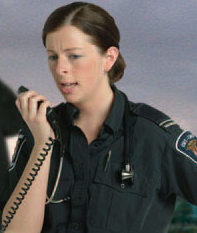Mobility is a crucial element in interoperable communications for public safety. It allows emergency responders to contact one another while out in the field. It also means that employees in emergency operation centers can take their LightSquared satellite phones/two-way radios along if they are forced to leave the building in an emergency.
 The MSAT-G2 push to talk radio communicates with the lightsquared satellite network and provides push to talk and PSTN voice services for all of North America and the northern portion of South American and the Carribean. The MSAT-G2 is both lightweight and practical, as it can be installed in vehicles, buildings, or put together as a “Go-Kit” for portable satellite communications. The “Go-Kit” comes in a water-resistant durable package that also comes with a battery that delivers power when on the go.
The MSAT-G2 push to talk radio communicates with the lightsquared satellite network and provides push to talk and PSTN voice services for all of North America and the northern portion of South American and the Carribean. The MSAT-G2 is both lightweight and practical, as it can be installed in vehicles, buildings, or put together as a “Go-Kit” for portable satellite communications. The “Go-Kit” comes in a water-resistant durable package that also comes with a battery that delivers power when on the go.
The MSAT-G2 satellite dispatch radio is comprised of three pieces of equipment: handset, transceiver and an L-Band antenna. The antenna is auto-acquiring/auto-tracking, as well as being a 16 channel GPS receiver. There are both land-mobile and maritime models of the antenna available. The latter model provides consistent satellite tracking, even in the roughest of waters. The handset can be used as a two-way radio or traditional telephone, with the transceiver sending and receiving signals to and from the satellite on LightSquared’s L-Band spectrum (1500/1600 MHz).
The MSAT-G2 can be connected to a standard telephone using a two-wire interface. This gives the user an experience that is more akin to using a traditional telephone. If attached to a cordless phone, the satellite coverage will extend throughout the entire space in the same way it would when using a cordless.
 Many different off the shelf interoperability modules and vehicular repeaters are compatibleMSAT G2 Satellite Radio with the MSAT-G2. It is possible to have interoperation between the MSAT-G2 and multiple different models and brands of wireless phones and radios with Push to talk capability using the interoperability modules. The range of the MSAT-G2 installed in a vehicle can be extended using vehicle repeaters. That set-up allows public safety workers to maintain connectivity in a car that has an LMR portable radio. The vehicle then works as the satellite repeater, allowing him to continue communications.
Many different off the shelf interoperability modules and vehicular repeaters are compatibleMSAT G2 Satellite Radio with the MSAT-G2. It is possible to have interoperation between the MSAT-G2 and multiple different models and brands of wireless phones and radios with Push to talk capability using the interoperability modules. The range of the MSAT-G2 installed in a vehicle can be extended using vehicle repeaters. That set-up allows public safety workers to maintain connectivity in a car that has an LMR portable radio. The vehicle then works as the satellite repeater, allowing him to continue communications.
There is a pair of services provided by the Lightsquared satellite network: telephony and push-to-talk radio service. The telephony service allows duplex callers to talk at the same time, much as they would be able to do with a landline or wireless phone call. GPS and directory assistance are also available. Other services such as call waiting, voicemail, call blocking, call forwarding, and conference calling are also available. At the current time, Lightsquared is the only North American commercial satellite operator to offer a push-to-talk services via satellite.
People that live in remote areas will regularly use Lightsquared’s two way Push to talk radio to communicate when an emergency arises. There is a familiarity between the two way, or dispatch, radio style and the public safety community, as it is perfect for command and control. Users can send a audio message to an entire talkgroup or choose instead to talk one-on-one in “private mode.”
 Lightsquared uses a “trunking” concept in their push-to-talk service that allows many different users to share a group of channels with the simple press of the PTT button. The network is designed to be as effective as possible despite having limited satellite power and bandwidth. Satellite power and call-handling resources are managed using demand assigned communication channels. “Call types” are also employed in the network to achieve the same results. When PSTN and cellular network congestion becomes a problem, Lightsquared’s group oriented communications take care of the issue by allowing large numbers to communicate on a single set of frequencies without ever using PSTN. A pre-defined period of activity defines when a frequency will be released.
Lightsquared uses a “trunking” concept in their push-to-talk service that allows many different users to share a group of channels with the simple press of the PTT button. The network is designed to be as effective as possible despite having limited satellite power and bandwidth. Satellite power and call-handling resources are managed using demand assigned communication channels. “Call types” are also employed in the network to achieve the same results. When PSTN and cellular network congestion becomes a problem, Lightsquared’s group oriented communications take care of the issue by allowing large numbers to communicate on a single set of frequencies without ever using PSTN. A pre-defined period of activity defines when a frequency will be released.
